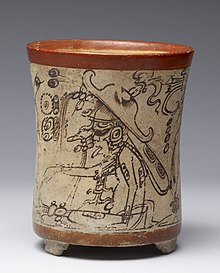Bees in mythology

Bees have been featured in myth and folklore around the world.
Mythology and folklore
African mythology
The Kalahari Desert's
In Egyptian mythology, bees grew from the tears of the sun god Ra when they landed on the desert sand.[6]
The
American mythology

In
Asian mythology
According to
In
In mythology found in Indian, ancient Near East and Aegean cultures, the bee was believed to be the sacred insect that bridged the natural world to the underworld.[17][18][19]
European mythology
In Mycenaean Greek and Minoan myth, the bee was an emblem of Potnia, also referred to as the "Pure Mother Bee".[22] Her priestesses received the name of Melissa, ("bee").[23] According to the Neoplatonic philosopher Porphyry, the priestesses of Demeter were also called "Melissae", and Melissa was a name of Artemis.[21] Melisseus was the god of honey and bees, whose daughters Ida and Adrasteia fed the infant Zeus with milk and honey when his mother hid him from Cronus.[24]
In European folklore and custom, telling the bees of important events in the family (particularly births and deaths) was vital to keep the bees content and happy in their hive.[25]
See also
- Bugonia
- For a Swarm of Bees
- Lorsch Bee Blessing
- Tholosor "beehive tombs" of Mycenaean culture: While "beehive-shaped", there is no known explicit relationship to the bee mythology of Mycenaean Greece.
Explanatory notes
References
Citations
- ^ Harrison (1922), p. 443.
- ^ a b Cook, Arthur Bernard. "The bee in Greek mythology" 1895 Journal of the Hellenic Society 15 pages 1–24
- S2CID 4177275.
- ISBN 9780715628270.
- ^ Chrigi-in-Africa. "The First Bushman / San". Gateway Africa. Retrieved 30 March 2017.
- ^ Norton, Holly (24 May 2017). "Honey, I love you: our 40,000-year relationship with the humble bee". The Guardian.
- ^ ISBN 978-0-7475-2502-8.
- ^ Ssemakula, James; et al. (eds.). "Kintu the Person vs Kintu the Legend". Archived from the original on 11 November 2020. Retrieved 19 April 2014.
- S2CID 145063130.
- ^ "Kintu – The First Human in Buganda". Archived from the original on 18 November 2014. Retrieved 19 April 2014.
- OCLC 40848420.
- ^ Kerr, Justin. "The Transformation of Xbalanqué or The Many Faces of God A1".
- S2CID 149734608.
- ISBN 978-0788504884.
- ^ "The Devi Bhagavatam: The Tenth Book: Chapter 13". sacred-texts.com. Retrieved 17 October 2017.
- ISBN 978-1-932476-03-3.
- S2CID 161354512.
- ^ Ransome, Hilda M. (1937). The Sacred Bee in Ancient Times and Folklore. London: George Allen & Unwin. pp. 19–41.
- ISSN 2323-5209.
- ^ Scheinberg, Susan 1979. "The Bee Maidens of the Homeric Hymn to Hermes". Harvard Studies in Classical Philology 83(1979), pp. 1–28.
- ^ a b Harrison (1922), p. 442.
- ^ G.W. Elderkin (1939) "The Bee of Artemis"The American Journal of Philology 60 pp. 203–213
- ^ Neustadt, Ernst 1906. De Jove cretico, (dissertation, Berlin). Chapter III "de Melissa dea" discusses bee-goddesses and bee-priestesses in Crete.
- ^ "Melisseus". Theoi Project. Retrieved 30 October 2021.
- ISBN 978-0-14-194162-2.
General and cited sources
- Harrison, Jane Ellen (1922) [1903]. Prolegomena to the Study of Greek Religion (3rd ed.). pp. 91 & 442f.
Further reading
- Berrens, Dominik (2018): Soziale Insekten in der Antike. Ein Beitrag zu Naturkonzepten in der griechisch-römischen Kultur. Göttingen: Vandenhoeck & Ruprecht (Hypomnemata 205).
- Engels, David/Nicolaye, Carla (eds.), 2008, "Ille operum custos. Kulturgeschichtliche Beiträge zur antiken Bienensymbolik und ihrer Rezeption", Hildesheim (Georg Olms-press, series Spudasmata 118).
- S2CID 191323024.
- James W. Johnson (April 1961), "That Neo-Classical Bee", Journal of the History of Ideas 22.2, pp. 262–266. JSTOR 2707837.

